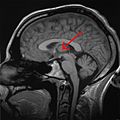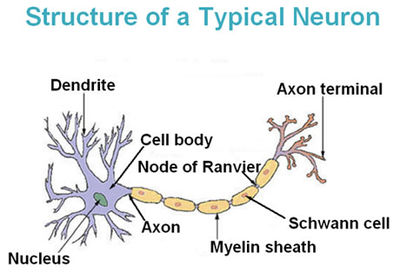Difference between revisions of "AY Honors/Brain and Behavior/Answer Key"
| Line 93: | Line 93: | ||
== 12. Find at least three references from the Bible that refer to your brain and/or to decisions that you make in life. == | == 12. Find at least three references from the Bible that refer to your brain and/or to decisions that you make in life. == | ||
| + | |||
| + | ==References== | ||
| + | http://staff.washington.edu/chudler/synapse.html | ||
| + | http://nobelprize.org/medicine/educational/synapse/intro.html | ||
Revision as of 05:09, 11 March 2006
Brain and Behavior
1. Be able to label a diagram or a model of a human brain including the following parts and tell briefly what each part does:
- Medulla oblongata.jpg
Medula
- Midbrain.jpg
Midbrain
- Cerebrum.jpg
Cerebrum
Medulla
The medulla controls the autonomic functions such as breathing, and heartbeat. These are things a person does not need to think about but which happen without concious effort.
Pons
The pons is a knob on the brain stem. It is part of the autonomic nervous system, and relays sensory information between the cerebellum and cerebrum.
Cerebellum
The cerebellum plays an important role in the integration of sensory perception and motor output.
Midbrain
Thalamus
The thalamus can be thought of as a relay station for nerve impulses carrying sensory information into the brain. It receives these sensory inputs as well as inputs from other parts of the brain and determines which of these signals to forward to the cerebral cortex.
Hypothalamus
The hypothalamus links the nervous system to the endocrine system by stimulating the secretion of hormones from the pituitary gland.
Pituitary gland
The pituitary gland secretes hormones regulating a wide variety of bodily activities, including hormones that stimulate other endocrine glands.
Cerebrum
The cerebrum is where thinking occurs. This is the area of the brain responsible for language, memory, and emotion, as well as motor control and the sense of smell.
2. What is a neuron? Draw a picture of a typical neuron and label its parts. Where does information enter a neuron and where does information leave from?
Neurons (also called nerve cells) are a major class of cells in the nervous system. In vertebrates, they are found in the brain, the spinal cord and elsewhere in the nervous system. Their primary role is to process and transmit neural information. One important characteristic of neurons is that they can generate and propagate electrical signals.
Neurons are discrete cells which communicate with each other via specialized junctions. Information enters the neuron primarily through the dendrites and exits through the axon.
Neurons communicate with one another and to other cells through synapses, where the axon terminal of one cell connects to a dendrite of another.
3. Explain how drugs affect the function of neurons especially at the 'synapse'. Make a commitment never to take drugs except for medical reasons.
Axons carry electrical signals from a neuron to the dendrite of another neuron. However, an axon cannot transmit these electrical signals directly to a dendrite - it needs a synapse to do this. The synapse converts the electrical impulse to a chemical reaction, which releases different types of chemicals called neurotransmitters. These neurotransmitters cause other chemical reactions which generate electricity in the dendrite.
The synapses can be "trained" to react strongly, weakly, anywhere in between, or not at all. It is because they can adapt that we are able to learn new things, form habits (good or bad), or suffer from addictions.
Drugs affect the way the synapse does its job, by preventing the incoming electrical impulse from causing a chemical reaction, preventing the chemical reaction from generating a new electrical signal to the the dendrite, or preventing the neurotransmitter chemicals from travelling through the synapse. Drugs can also amplify these reactions, so that they are more intense than they would have been in the absense of the drug.
4. What is a reflex? Perform a knee-jerk reflex test on someone. Explain why it occurs (use the following terms in your answer: sensory neuron, motor neuron, spinal cord). Why do doctors use this test in a physical exam?
Instructions: Gently tap someone just below the knee-cap while the person's leg is hanging over the edge of a chair.
5. What is a sensory neuron, and what is "adaption". Demonstrate adaption by doing the following:
Rest your arm on a table and then place a small cork (or something very light) on your arm. Notice how it feels at that time and how it feels one minute later after not moving.
Place one finger of one hand in a bowl of cool water and another finger of the other hand into a bowl of warm water. After 30 seconds, put both fingers in to a bowl of water at room temperature. How does the water at room temperature feel on each finger?
What spiritual lesson can be drawn from the concept of adaption?
6. How are the senses of taste and smell similar and how are they different.
Draw a map of which part of the tongue responds to the following tastes: sweet, sour, bitter, salt. Instructions: Have someone dip a Q-tip into one of the following: sugar water (for sweet), lemon juice (for sour), flat tonic water (bitter) or salty water (salt), and then lightly touch different parts of your tongue. Notice which areas of the tongue taste the solution that is being tested. Rinse with pure water between each test and use a new Q-tip for each test.
7. Draw a picture of the various parts of the eye and explain why you have a blind-spot. Find your blind-spot for one eye.
Instructions: Place a very small black dot on the center of a white piece of paper. Close one eye and stare directly ahead. Hold the paper at arms length in front of you and move the paper until the spot "disappears" (usually this is occurs when the dot is just a bit below eye level - it is important).
8. Describe the three basic parts of the ear and tell what each part does. Explain why the following activities can be bad for your hearing:
listening to a "walkman"
putting something long in your ear
being in the front row at a loud music concert
not treating an ear infection properly
standing behind a jet at an airport
9. Do one or more of the following activities: (some of these activities will need to be planned with a medical/dental professional or at a local college or university— they are usually very willing to assist you)
Observe an electroencephalogram or one being performed on someone and describe what can be learned from this test.
Watch a "lie-detector" test being performed. Briefly explain how one works.
Observe an MRI or one being performed and explain what information can be learned from such a test.
Observe a neuron under a microscope.
Observe someone receiving an local or general anesthetic and explaining how an anesthetic works.
Observe a real human brain (fresh or preserved)
10. List at least 5 things that you can do to protect your brain from damage.
11. Do one of the following:
Visit and help care for someone (minimum of 2 hrs) who has a disease of the brain and report on their special needs.
Briefly describe the following disorders of the nervous system:
Alzheimer's Disease
Multiple Sclerosis
Epilepsy
Major Depression
Down Syndrome
Huntington's Disease
Quadriplegic and Paraplegic
12. Find at least three references from the Bible that refer to your brain and/or to decisions that you make in life.
References
http://staff.washington.edu/chudler/synapse.html http://nobelprize.org/medicine/educational/synapse/intro.html






